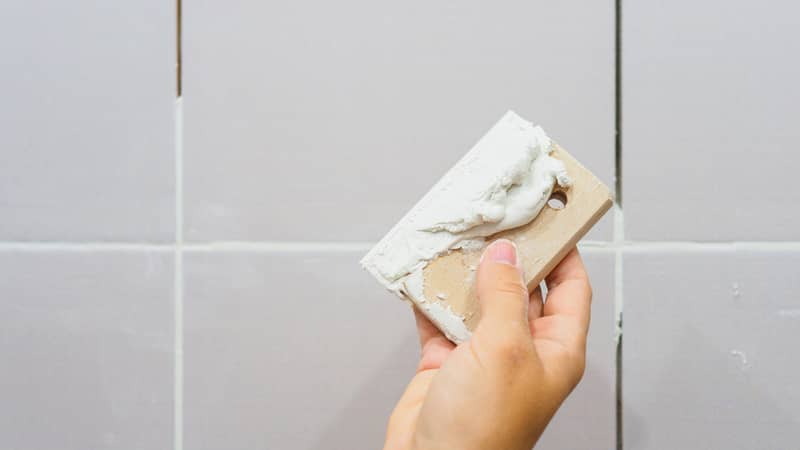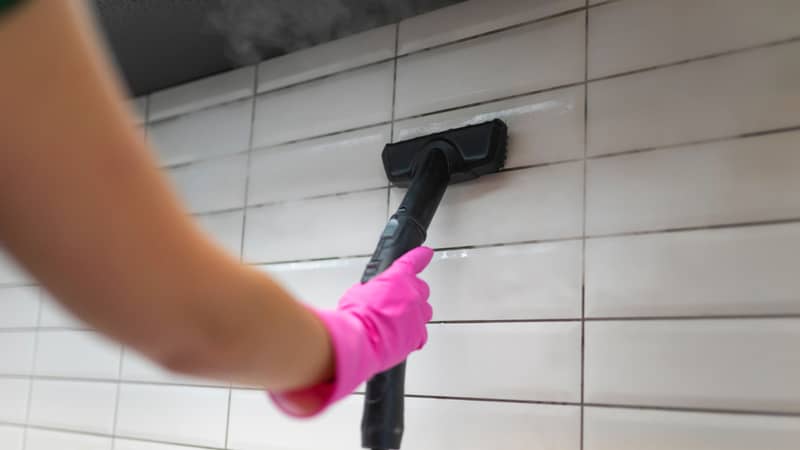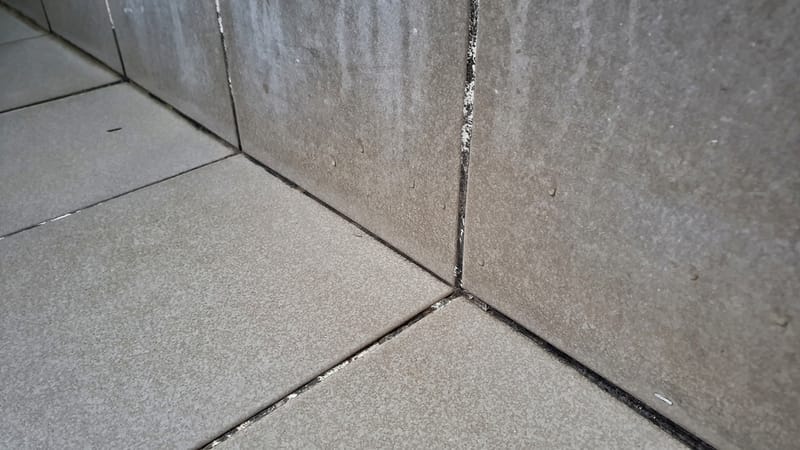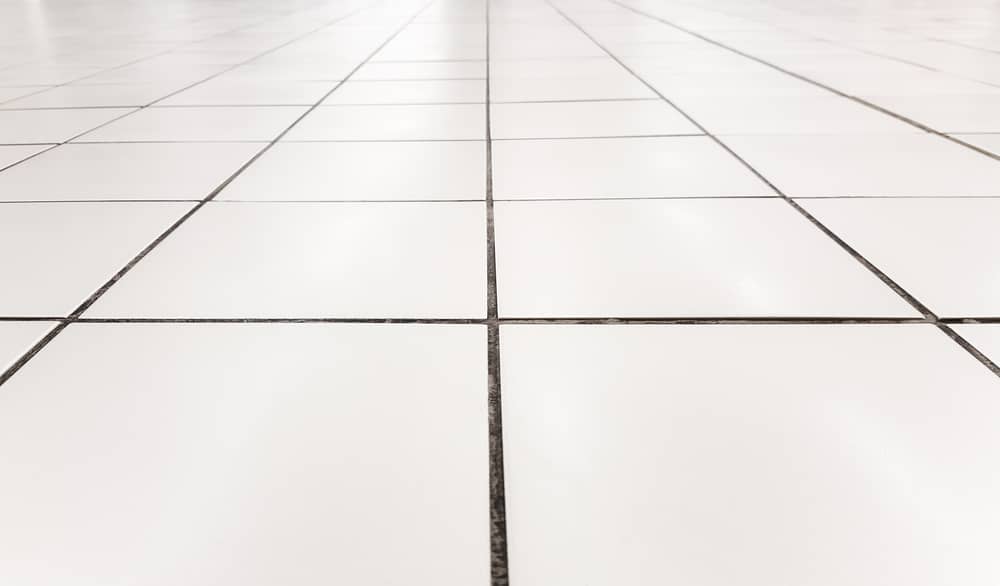Cleaning grout takes a lot of elbow grease, but it’s essential to making tiles look pristine. No matter how clean and sparkling your tiles are, if the grout is dirty… well, the surface will look dirty too.
Most grout cleaning guides are for sealed grout, but how to clean unsealed grout? It’s tricky, since unsealed grout stains easily and absorbs moisture (which could cause mould).
Still, there are some methods to tackle unsealed grout:
Once you’ve cleaned the grout and let it dry completely, apply a grout sealer ASAP. Leaving grout unsealed is more trouble than it’s worth!
Sealed Grout vs. Unsealed Grout
Sealed grout means a sealer has been applied to the grout after it has dried. It makes the grout more resistant to dirt and moisture, although it should be reapplied at least once a year.
You should clean grout before applying the sealer.
On the other hand, unsealed grout has not yet been coated with a sealer. This is typical for newly installed tiles or much older floors.
Why You Need to Seal Tile Grout

Most households use cement-based grout, which is a porous material. When unsealed, grout easily absorbs dirt, spills, and moisture – leading to stains and mould.
Unsealed grout is also more prone to cracks and other damage, which could eventually require re-grouting. Sealing your grout will save you time, effort, and money in the long run.
Before Cleaning Unsealed Grout
Make sure the grout has fully cured or dried, or you could damage the finish.
When cleaning unsealed grout on a tile floor, start by sweeping or vacuuming any loose dirt and debris. You can follow that up with a light mopping using warm water and dish soap.
For tile walls and other surfaces, wipe the dust away with a dry microfibre cloth or use a duster.
If you’re cleaning new tiles after installation, remove the grout haze using a specialised cleaner or a vinegar and water solution.
How to Clean Unsealed Grout
While you can clean unsealed grout, it’s possible the stains or discolouration could be permanent. Depending on how long the grout has been stained or dirty, you might not be able to restore it.
If you use professional house cleaning services, warn them that you have unsealed grout!
Worst case scenario, you may need to have the tiles regrouted.
Precautions for cleaning unsealed grout
Be mindful of your cleaning solutions for unsealed grout! There are some substances you should not mix as they create dangerous reactions.
Never combine bleach with anything other than water. Additionally, do not combine ammonia and vinegar, or hydrogen peroxide and vinegar.
Always wear protective equipment when cleaning – that includes long rubber gloves, a face mask, and goggles or similar eye protection.
Test your cleaning solution in a small area first to make sure it won’t damage the grout or tiles.
Cleaning unsealed grout with baking soda

This is the best solution for unsealed grout that’s only mildly dirty, or for stone tile surfaces.
Make a paste out of baking soda and water. Avoid using vinegar as this could neutralise the baking soda before cleaning.
Use a stiff-bristled brush (like an old toothbrush) to apply the paste to the grout lines and scrub them clean.
Rinse the surface afterwards with clean water, then mop or wipe it dry.
Cleaning unsealed grout with white vinegar
Be careful with using vinegar on unsealed grout, since the acid can degrade cement-based materials with prolonged exposure. Never use vinegar on stone tiles and never mix it with bleach.
Mix equal parts vinegar and warm water in a spray bottle – diluting the vinegar will make it less hazardous for the grout. Apply the solution to the grout lines.
Let the cleaning solution sit for 30 minutes at most, then scrub the grout with a brush. Rinse the surface thoroughly with clean water before wiping it dry.
Cleaning unsealed grout with hydrogen peroxide
Avoid using this on coloured grout, since hydrogen peroxide can lighten or even strip pigments. Do not use this on natural stone tiles as it will discolour or damage the material.
Pour some hydrogen peroxide into a spray bottle, then saturate the grout. Work in small sections, going top to bottom or starting from the corner furthest from the door.
Let the hydrogen peroxide sit for about 10 minutes, then scrub the grout with a grout brush or stiff-bristled brush. Wipe the dirty residue away with a damp cloth or sponge.
When you’ve cleaned the entire surface, rinse it with fresh water and let it dry.
Cleaning unsealed grout with steam

If you have a steam cleaner, you can perform a more thorough cleaning. The high-pressure steam forces any dirt and debris out of the grout, which you can mop or wipe away.
A steam cleaner is also one of the more efficient ways to clean unsealed grout on tile floors.
Choose a brush or nozzle in the appropriate size for the grout lines. When cleaning, work in small sections and clean up the dirty water before it seeps back into the grout.
Hold the nozzle a few centimetres above the surface – but not too far, or the steam won’t penetrate.
Let the grout dry completely afterwards. You can use a dry mop or cloth to remove excess moisture, then point an electric fan at the tiles for a few hours.
Cleaning unsealed grout with oxygen bleach
This is your last resort, since bleach is a harsh cleaner and can degrade unsealed grout (especially if it’s old grout). Oxygen bleach is less reactive than chlorine bleach, so it’s the “safer” option.
Dilute the bleach according to the package instructions. Work in small sections, applying the bleach solution then letting it sit for a few minutes.
Scrub the grout with a grout brush or soft-bristled brush. Rinse the bleach immediately with a wet mop or cloth, then rinse the mop in clean water.
Wipe off the excess moisture before moving to the next section.
How to Remove Mould From Unsealed Grout

For mild to moderate cases of mould, you can use hydrogen peroxide. The 3% solution will work for mild cases, but you can use a higher strength (such as 6%) for more effective removal.
Open all windows and doors to the room you’re working in, and switch on the exhaust fan if there is one. Wear protective equipment such as rubber gloves, a face mask, and goggles.
Spray the hydrogen peroxide onto the affected areas and let it sit for about 10 minutes. Use a grout brush or stiff-bristled brush to scrub the mould off.
Use a wet cloth or sponge to rinse the residue. Repeat as necessary until the grout is clean.
You can also mix a paste of hydrogen peroxide and baking soda for extra cleaning power. Just be sure to throw out any leftover paste when you’re done – the combination creates carbon dioxide, which could build inside a sealed container and cause it to explode.
For more severe cases, you can use a solution of 1 part bleach to 4 parts water. Apply to the grout lines with mould, then let it sit for at most 30 minutes.
Scrub with a grout brush or other stiff-bristled brush, then rinse thoroughly with warm water.
Proper Grout Maintenance
Once you’ve cleaned the unsealed grout, let it dry completely. Keep the room well-ventilated and, if possible, point an electric fan at the surface.
After the grout has dried, apply the appropriate grout sealer and let it cure. Note that acrylic, epoxy, and urethane-based grouts do not require sealing, but double-check with the company that handled the installation!
Do not leave your grout unsealed. Repeatedly cleaning unsealed grout will cause the material to degrade, and you’ll eventually need to have the surface re-grouted.
Deep clean tile grout around once a year. For regular maintenance, you can scrub or mop the grout whenever you clean your floors or walls.
Reapply the grout sealer once a year.

